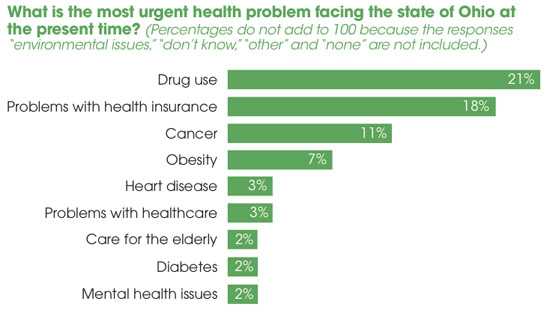Drugs, insurance top healthcare concerns
VW independent/submitted information
Many people in Ohio worry about health issues. The 2016 Ohio Health Issues Poll (OHIP), sponsored by Interact for Health, asked Ohio adults how they feel about health in the state overall and about their personal health.

When asked the most urgent health problem facing the state (respondents could provide any answer), the most frequent responses were drug use (21 percent) and problems with health insurance (18 percent). Concerns about health insurance included cost, coverage gaps when insured, accessibility to all groups, and general concerns about the Affordable Care Act, also known as Obamacare.
About 1 in 10 Ohio adults said cancer (11 percent) or obesity (7 percent) was the top health problem in the state. Other responses included heart disease, problems with health care, care for the elderly, mental health issues, and diabetes. OHIP’s findings are similar to national surveys.
“These results help us determine the issues Ohio adults are facing and how to best focus our efforts to serve their needs,” says O’dell M. Owens, M.D., M.P.H., president/CEO of Interact for Health. “The Board and staff of Interact for Health are pleased to provide these data so that we may keep our neighbors informed of these issues.”
OHIP also asks adults to rate their general health. Research has found a powerful link between people’s response to this question and the predicted length and quality of their lives. In 2016, half of Ohio adults (48 percent) reported that their health was excellent or very good. More than 3 in 10 adults (34 percent) said their health was good. Almost 2 in 10 adults (18 percent) said their health was fair or poor. This is about the same as in 2015.
Adults with higher incomes were more likely to have better self-reported health. Among those earning more than 200 percent of the Federal Poverty Level (FPL), nearly 6 in 10 (58 percent) reported excellent or very good health. That compares with fewer than 4 in 10 adults earning 200 percent FPL or less (36 percent). This gap has been consistent over the past decade. “These findings match national and international work that has identified economic stability as one of the key social factors that influence health,” says Susan Sprigg, Interact for Health research officer.
Education is another factor that influences health. Six in 10 college graduates (61 percent) reported excellent or very good health. This compares with 5 in 10 adults with some college (51 percent), and only 4 in 10 adults with a high school diploma (39 percent) or less education (41 percent).
“These results highlight the connection between education, income, and health, and call us all to focus on addressing the social determinants of health,” says Ross Meyer, vice president-community impact for United Way of Greater Cincinnati.
“Despite federal and state policy decisions in recent years that have increased access to health insurance coverage, it is clear that many Ohioans are still concerned about having access to quality, affordable health care,” added Amy Rohling McGee, president of Health Policy Institute of Ohio. “In addition, it’s important to remember that access to care alone is not sufficient to address all of the health concerns of Ohioans. There are many factors that contribute to improved health, most of which take place outside of what is typically considered the health care system.”
More information about Ohioans’ opinions on urgent health problems, and other topics, is available at www.interactforhealth.org/ohio-health-issues-poll.
About the Ohio Health Issues Poll
The 2016 Ohio Health Issues Poll (OHIP) is funded by Interact for Health. OHIP was conducted July 14 – Aug. 5, 2016, by the Institute for Policy Research at the University of Cincinnati. A random sample of 863 adults from throughout Ohio was interviewed by telephone. This included 439 landline telephone interviews and 424 cell phone interviews. In 95 of 100 cases, statewide estimates will be accurate to ± 3.3%. There are other sources of variation inherent in public opinion studies, such as non-response, question wording or context effects that can introduce error or bias. For more information about the Ohio Health Issues Poll, visit www.interactforhealth.org/ohio-health-issues-poll.
POSTED: 12/17/16 at 7:55 am. FILED UNDER: News







